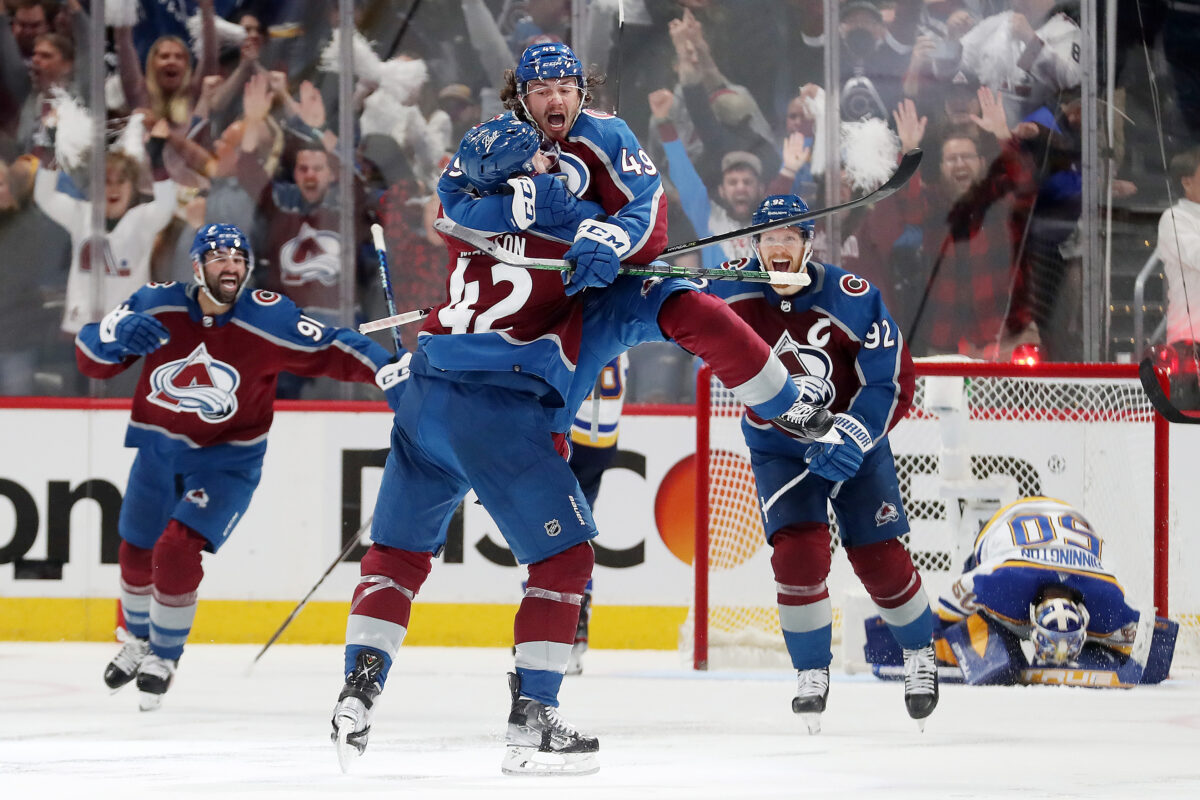With one stroke of a pen, the Colorado Avalanche’s Nathan MacKinnon becomes the highest-paid player in the NHL and the highest-paid of the salary cap era, beginning as of the 2023-24 season. The $12.6 million average annual value (AAV) attached to his new contract lifts him over Connor McDavid of the Edmonton Oilers, the previous record-holder ($12.5 million).
Since the introduction of the salary cap prior to the 2005-06 season, the NHL’s history is littered with superstars making a significant share of their team’s allocated space. Despite the hefty price tag, MacKinnon’s extension provides the Avalanche with surplus value and cost certainty over the life of the deal, allowing them to construct a team capable of winning multiple Stanley Cups during his tenure. Now, let’s dig into how his new deal positions Colorado to be the NHL’s latest dynasty hopefuls.
MacKinnon Contract Represents Fair Value for the Avalanche
When asked about future contract negotiations back in 2019, the Avalanche’s superstar center stated that he would take a discount on his next deal, citing his desire to bring another Stanely Cup to Colorado. Time has a tendency to make a mockery of us all, however, and MacKinnon entered the 2022 offseason with arguably the most leverage of any player in the salary cap era after accruing a number of individual and team accolades.
Over the past three seasons, MacKinnon sits sixth in overall scoring but third in points-per-game (P/G), only lagging behind the Oilers’ dynamic duo of McDavid and Leon Draisaitl. Since his first postseason appearance in the 2014 Playoffs, he ranks third among all players in playoff P/G, once more outflanked by the Oilers’ superstars. Although teammate Cale Makar took home the Conn Smythe Trophy as the most valuable player of the Avalanche’s Cup run, the 27-year-old pivot led the playoffs in goals (13) and shots (117). The latter mark eclipsed his peers by a wide margin, as he took 40 more shots than Nikita Kucherov in second place.

Apart from winning the 2019-20 Lady Byng Trophy, MacKinnon’s individual trophy cabinet is relatively bare and may give others pause as they consider whether he is worth the moniker of the NHL’s highest-paid player. Although he’s been named a finalist for the Hart Trophy on three occasions (2017-18, 2019-20, 2020-21) and twice as an NHL Second-Team All-Star (2017-18, 2019-20), the two MVP awards have evaded him thus far. Still, in a league in which the likes of Sidney Crosby, McDavid, and Auston Matthews also play down the middle, even earning that level of recognition is a noteworthy accomplishment.
The final factor that must be considered is MacKinnon’s contractual status at the time of signing. With one more season left on his sweetheart deal, he was set to become an unrestricted free agent (UFA) in the summer of 2023 and hit the open market as a 27-year-old center at the height of his powers. All three of Draisaitl, McDavid, and Matthews – his closest age and positional comparables – entered their most recent contract negotiations as restricted free agents (RFA) under team control, significantly limiting their leverage. Given their collection of individual awards, statistical achievements, and a potential jump in the cap in the near future and it’s very likely all eclipse MacKinnon’s current hit, although none of the three have seen their teams match the Avalanche’s championship pedigree (yet).
You May Also Like:
- Avalanche Will Have Limited Representation at 2025 World Junior Championship
- 3 Takeaways From the Avalanche’s 8-2 Loss to the Lightning
- Hagel’s Historic Night Leads Lightning to Blowout Win Over Avalanche
- Projected Lineups for the Avalanche vs Lightning – 11/25/24
- Projected Lineups for the Avalanche vs Lightning – 11/24/24
All things considered, MacKinnon’s new contract is a fair deal for both sides. He is made whole for playing on a bargain of an agreement for the past seven seasons (although that’s mostly due to an unremarkable start to his NHL career) and the Avalanche retain their superstar talent through the rest of his prime on a relatively manageable pact. It’s now up to the recently promoted general manager Chris MacFarland to navigate the team’s new salary situation, a task he looks capable of executing with ease considering the secure state of the Avalanche’s cap commitments.
MacKinnon’s Extension Gives Avalanche Long-Term Cost Certainty
With the signing of the long-awaited extension, the Avalanche have locked up the entirety of their Stanley Cup-winning core. With respect to the future contract extensions for Alex Newhook, Bowen Byram, and Devon Toews, they have the freedom to maneuver the salary cap without the guillotine of earth-shattering deals looming overhead.
The Avalanche now have MacKinnon, Makar, Mikko Rantanen, Gabriel Landeskog, and Valeri Nichushkin under contract until the 2025 offseason for a combined hit of just under $44 million. That’s not to mention those who have deals for the next two seasons and beyond including Devon Toews (expires 2024), Alexander Georgiev (2025), Josh Manson (2026), Artturi Lehkonen, and Samuel Girard (both 2027).

Both Newhook and Byram’s expire next summer but will still be RFAs under team control. Given the outsized impact of points in contract negotiations, developing the pair while suppressing their production should be the Avalanche’s primary objective in 2022-23. Newhook could replace Nazem Kadri as the second-line center, but faces stiff competition from veteran pivots in newcomer Evan Rodrigues and J.T. Compher for the plush role. Byram’s path to juicing his point totals is obstructed by the team’s star blueliners in Makar and Toews, with Girard also capable of running a powerplay when healthy.
A true breakout campaign from either of the blossoming youngsters could make next summer’s negotiations uncomfortable for the Avalanche, but the management team has demonstrated the ability to wriggle out of cap dilemmas in the past. Regardless of the future concerns, having the team’s leading men under contract offers some level of certainty for years to come.
The $10 Million Player Myth is Overblown
One ubiquitous argument within hockey discourse is the factoid which states that no NHL franchise has ever won the Stanley Cup in the cap era with a player making $10 million or more against the cap. That slippery half-truth conveniently ignores the fact that, if using the percentage of the cap that the player takes up rather than the raw total, the feat has already been accomplished several times. Remember, adjust for inflation!
Using the 2022-23 season’s cap ceiling of $82.5 million, a cap hit of $10 million currently represents a 12% cut of the pie. The following table presents the players who have won a Stanley Cup since 2005-06 while earning the equivalent of $10 million at the time:
| Player | Season | Cap Hit | Cap Hit % | 2022-23 Value |
|---|---|---|---|---|
| Chris Pronger | 2006-07 | $6.25 | 14.2 | $11.72 |
| Nicklas Lidstrom | 2007-08 | $7.6 | 15.1 | $12.46 |
| Sidney Crosby | 2008-09 | $8.7 | 15.3 | $12.62 |
| Zdeno Chara | 2010-11 | $7.5 | 12.6 | $10.4 |
| Sidney Crosby | 2015-16 | $8.7 | 12.2 | $10.07 |
| Evgeni Malkin | 2015-16/2016-17 | $9.5 | 13.3/13 | $10.97/$10.73 |
| Alexander Ovechkin | 2017-18 | $9.54 | 12.7 | $10.48 |
Although Sidney Crosby’s 2016-17 adjusted cap hit comes in at $9.82 million, the difference – as is the case with more recent Cup winners – is negligible. Both Nikita Kucherov and Andrei Vasilevskiy carried a cap hit of $9.5 million for the 2020-21 season while leading the Tampa Bay Lightning to their second consecutive Stanley Cup. The Russian winger also held the same cap hit the previous season, although the Lighting’s infamous cap maneuvering in a unique situation muddles the research of that particular season. The 2013-14 Los Angeles Kings also saw Marian Gaborik come in at just over 11% of the cap that season, another example within arm’s reach of the fabled $10 million mark. Rantanen ($9.25 million) also approached the threshold just last season with the Avalanche.
If you want to be pedantic about those latter examples, go ahead. The truth remains that teams have managed to construct Cup-worthy rosters while carrying significant cap hits stemming from a single player and those sizeable commitments. A skilled front-office team can find impactful bargains and make the difficult decision to cut ties with players generating a suboptimal return on investment. Considering the string of bullseyes dotting the track record of Colorado’s management group, one would be wise to bet on their continued success.
Avalanche in Good Position to Emulate Cap-Era Giants
You can argue over semantics and how strict one should be with the financial yardstick, but the reality is that teams have won with players making more than $10 million – sometimes more than one! In any case, it’s best to pay your stars and figure the rest out along the way. That’s the bet the Avalanche are making going forward, and it’s a method of roster construction that revered franchises of the cap era like the Lightning and the Pittsburgh Penguins have accomplished on multiple occasions.
MacKinnon will hit his mid-30s at the end of the deal, giving the Avalanche several more years of something resembling his peak performance. Given that the rest of its core is locked up to reasonable commitments, the organization is not in dire straits. With enough care and precision, the Avalanche have the potential to join their Eastern Conference counterparts atop the Mount Rushmore of the NHL’s cap-era giants.
Data courtesy of CapFriendly, Hockey Reference, and the NHL.